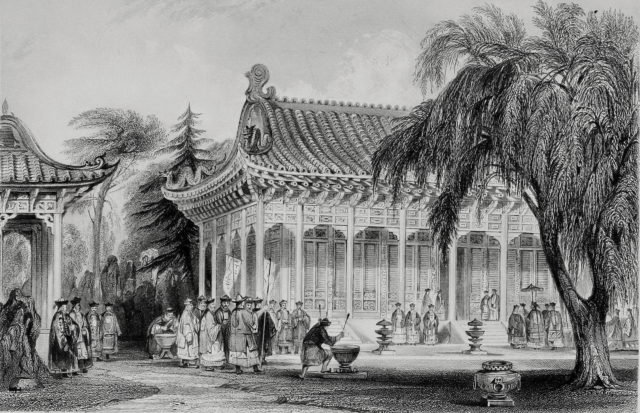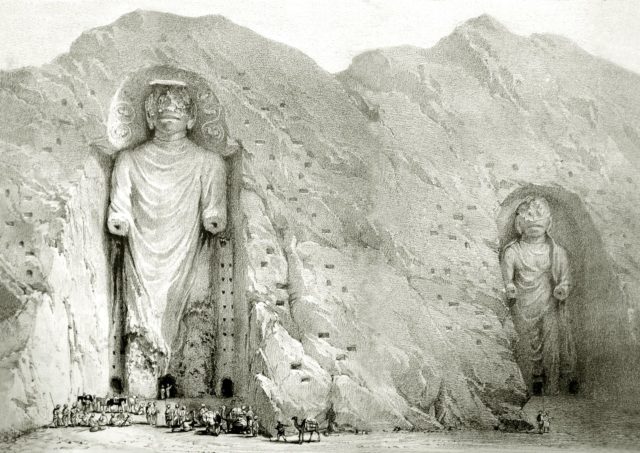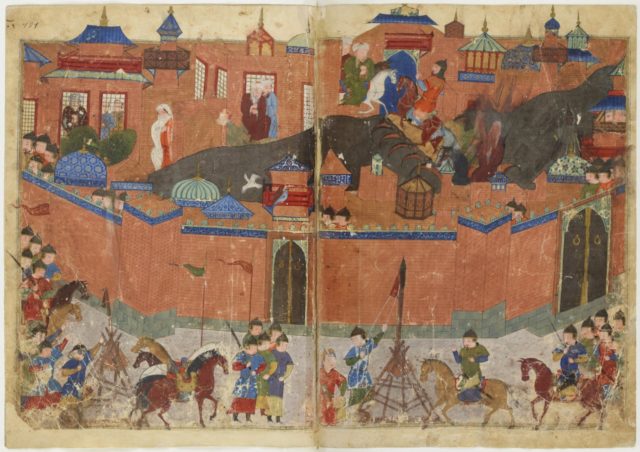The destruction of cultural artefacts and heritage sites during war has been the norm throughout history, whether intentional or not. Unfortunately, cultural heritage continues to be one of the many casualties of war, often having a profound and lasting impact on the heritage and identity of communities caught in the crossfire.
10. Royal Opera House, Malta

Throughout World War II, and particularly on the European front, numerous works of art and other cultural artefacts were threatened by bombing as cities and cultural centres became targets of war. The Royal Malta Opera House was one such institution, almost completely destroyed by German and Italian bombers.
The building was damaged April 7, 1942 Although the bombers initially intended to hit the outskirts of Malta's capital, Valletta, they still caused significant damage to historic buildings and cultural institutions on the island.
Built in the 18th century, the Royal Opera House served as a venue for opera, ballet and other theatrical arts. However, despite the damage, the building was eventually restored and continues to function to this day.
9. Old Summer Palace, China

The destruction of the Old Summer Palace in Beijing, also known as Yuanming Yuan , was an important event in early modern Chinese history. It occurred during the Second Opium War of 1860 between the Qing Dynasty and the British and French expeditionary force over trading rights in China.
October 18, 1860 castle was looted and burned to the ground by the Allied forces led by Lord Elgin, the British High Commissioner in China. The palace, a lavish and sprawling complex of gardens, lakes and buildings, was used by the Qing emperors as a summer retreat and was considered a symbol of the empire's culture and power. Its destruction was a huge blow to the Qing dynasty and is still remembered as an important event in the country's history in China. Even today tens of thousands Visitors come from all over the country to see the well-preserved ruins, although scientists and other experts have repeatedly called for their restoration in recent years.
8. Buddhas of Bamiyan, Afghanistan

The Buddhas of Bamiyan are two ancient rock-cut Buddha statues in Hazarajat, Afghanistan. Built in sixth century The towering structures, 180 and 124 feet high, were examples of Gandhara period Buddhist art until they were destroyed by the Taliban in 2001.
Having seized power in 1996, they considered all parts of Afghanistan's non-Islamic heritage to be alien and on February 26, 2001, they announced their intention to destroy the Buddhas, reducing them to March 14 .
The destruction of the Bamiyan Buddhas was met with widespread international condemnation, as it was seen as a symbolic victory for the extremist ideology of the Taliban. Today, only ruins remain of what was once an impressive structure from Afghanistan's golden age, despite the previous government's best efforts to restore them to their former glory.
7. Winged Bull of Nineveh, Iraq
In 2014, ancient cultural and archaeological sites across Iraq were seized and targeted by the Islamic State of Iraq and Syria (ISIS), a radical Islamic group that sought to… well, you know, ISIS. They considered many of these artifacts blasphemous and sought to destroy them entirely because they did not fit into their particular view of the region’s history.
February 26, 2015 « Islamic State releases video of destruction The Winged Bull of Nineveh and other artifacts in the Mosul Museum after they captured ancient Nineveh in Mosul, Iraq. It showed armed militants using sledgehammers and power tools to destroy the impressive stone structure, which dates back to the Assyrian Empire in the seventh century B.C., also known as one of the cradles of human civilization.
6. Old City of Sana'a, Yemen
The Old City of Sana'a, also called the Old City, is a historic district located in the capital of Yemen. It is known for its distinctive architecture and ancient landmarks, including the Great Mosque of Sana'a, built in the seventh century Due to its cultural and historical significance, the Old Town was recognized as a UNESCO World Heritage Site in In 1986 .
In 2015, Yemen became embroiled in a civil war between the government, backed by a Saudi-led coalition, and the Houthi rebel group. According to reports , it is one of the deadliest ongoing conflicts, having claimed the lives of at least 377 000 people by the end of 2021. One of the first victims was the Old City, which was allegedly bombed by the Saudi-led coalition in June 2015 . It destroyed much of it, including causing irreversible damage to some of its iconic buildings, such as the Great Mosque.
5. Benin City, Nigeria
Benin City was once the capital of the Kingdom of Benin, a powerful West African empire that flourished between the 14th and 19th centuries in what is now Nigeria. It was known for its advanced political and social system, as well as its sophisticated art and architecture. The city was home to many important cultural landmarks, including the Royal Palace and the Oba’s Palace. By one estimate, Benin City’s walls were at least four times as long Great The Great Wall of China.
Unfortunately, the Benin Empire fell into the path of British colonization, and the capital was destroyed by British troops during the punitive expeditions in 1897. According to eyewitnesses, it was looted and burned to the ground, and almost all of its most valuable property, including its famous sculptures made of bronze and ivory , was taken to Europe to be sold at private auctions. Although Benin still exists as a modern city in Nigeria, it is nothing like what it once was.
4. National Museum of Iraq
The National Museum of Iraq in Baghdad houses a vast collection of artefacts and historical treasures, including ancient tablets and cuneiform texts , sculptures and jewelry from ancient Mesopotamia. Its collection spans more than 5,000 years, from Sumerian civilizations before the Ottoman Empire. Unfortunately, it would also become one of the many casualties of the Iraq War, as most of its valuable artifacts were looted during the first few months of the invasion.
It began on April 10, 2003, when the collapse of the Iraqi government left the museum unattended. Although there were reports that American soldiers tried to stop it, the looting continued for several days, resulting in the loss of many of the most valuable exhibits museums were lost While more than 8,000 exhibits were fortunately removed and preserved by staff, about 15000 were stolen within 36 hours, including archaeological material from some of the oldest sites in the Middle East.
3. Nabi Yunus Mosque/Tomb of Jonah, Iraq
The ancient Nabi Yunus Mosque, also called the Tomb of Jonah, in Mosul, Iraq, was built on an archaeological site dating back to the eighth century BC It was a symbol of the region's history of peaceful coexistence and ethnic diversity, as Muslims, Christians and Jews considered this place sacred .
As you may have guessed from the general theme of this list, the tomb became a target for Islamic State militants after they conquered large swathes of Iraq in 2014, including the city of Mosul. It was finally destroyed by explosives and artillery on July 24, 2014, along with the ancient artifacts buried beneath it. According to locals, cultural sites near the tomb before destruction were strong plundered , although we still don't know the full extent of what was stolen.
2. Flakturm Friedrichshain, Germany

The Second World War resulted in the destruction of much of Europe's cultural heritage, particularly in Germany during the latter part of the war. One example was the loss of art in Flakturm Friedrichshain — an anti-aircraft tower located in Berlin, Germany, that was used to store valuable works, including works by artists such as Pablo Picasso and Henri Matisse.
It was also a defensive position, as the tower housed anti-aircraft guns and bunkers in case of attack. Obviously, as we all know how the war ended, this was not enough, and in April 1945 the tower was heavily shelled by the Allied forces advancing on Berlin, burning down more than three floors paintings, sculptures and other works of art from all over Europe.
1. House of Wisdom, Iraq

The House of Wisdom, also known as Bayt al-Hikma, was a significant cultural institution in the Islamic world. Located in Baghdad, Iraq, it was founded in the eighth century during the reign of the Abbasid Caliph Harun al-Rashid. It was a center of learning and scholarship, and home to perhaps the largest collection of manuscripts in the world at the time, which played a key role in the flourishing of science and culture during the Golden Age Islam .
All this ended tragically in 1258, when the city was sacked by the Mongol invasion led by Hulagu Khan. According to survivors, so many books were thrown into the Tigris River that it turned black from ink It was a major event in Islamic history, abruptly ending the golden age and setting the city back decades, perhaps centuries.













Оставить Комментарий